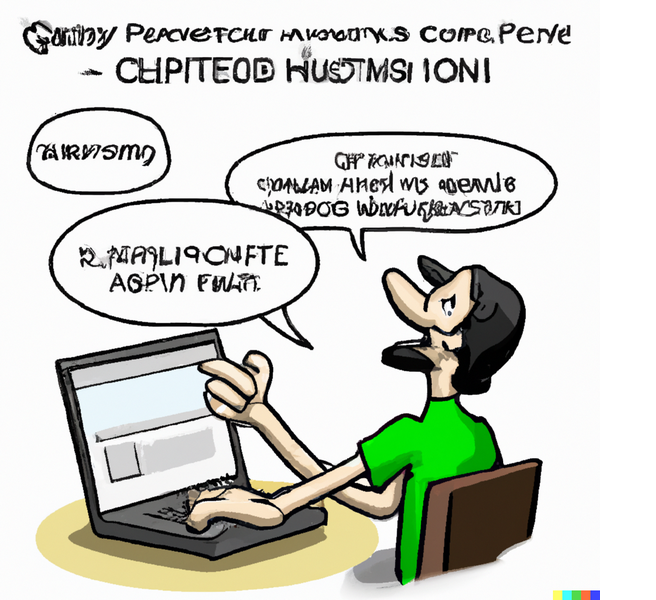 The reaction I rarely see when discussing artificial intelligence with anyone is indifference. The reactions I usually see are split between overflowing enthusiasm and overflowing concern. I rarely have a conversation about them both. But after writing a few articles on how useful it is, and obviously I spend most of my time in the overflowing with enthusiasm camp, I wanted to address the elephant in the room.
The reaction I rarely see when discussing artificial intelligence with anyone is indifference. The reactions I usually see are split between overflowing enthusiasm and overflowing concern. I rarely have a conversation about them both. But after writing a few articles on how useful it is, and obviously I spend most of my time in the overflowing with enthusiasm camp, I wanted to address the elephant in the room.
Category: Studio Tips
Quick tips on how to do things in Studio
The elusive regex with GPT-4
 Whilst the solving of regular expressions with ChatGPT seems like a great way to give yourself superpowers I have stayed away from writing about this usecase till now. Yes, ChatGPT is great for those simple things that anyone with some basic knowledge could probably write themselves in the time it took to explain what was wanted. But I like regular expressions… I’m definitely not a real expert, but I do like to play around with them and would consider myself above an average user. So when I decided to test ChatGPT with a regular expression I asked it to solve something I have never been able to achieve on my own. In fact I have never seen anyone else do this either… although I’m certain there are many people out there who would be very capable of doing it. But when I’ve asked I have never had a satisfactory solution without using code, or without using multiple search & replace operations.
Whilst the solving of regular expressions with ChatGPT seems like a great way to give yourself superpowers I have stayed away from writing about this usecase till now. Yes, ChatGPT is great for those simple things that anyone with some basic knowledge could probably write themselves in the time it took to explain what was wanted. But I like regular expressions… I’m definitely not a real expert, but I do like to play around with them and would consider myself above an average user. So when I decided to test ChatGPT with a regular expression I asked it to solve something I have never been able to achieve on my own. In fact I have never seen anyone else do this either… although I’m certain there are many people out there who would be very capable of doing it. But when I’ve asked I have never had a satisfactory solution without using code, or without using multiple search & replace operations.
When error messages attack: using ChatGPT to make peace with your users!
 I’m sure everyone reading this is no stranger to the often completely unintelligible error messages that can be generated when software goes wrong! You can even find in the most voted for ideas in the RWS Community ideas platform that is related to just that, “Get those cryptic error messages more human“. As computers have become more and more complicated and software is relying heavily on inbuilt technologies provided with the operating system, 3rd party libraries, and add-ons that use the APIs, it’s really no surprise that things can go wrong. But do the messages really have to be so complicated and meaningless for the average user? Why don’t developers make them easier to understand?
I’m sure everyone reading this is no stranger to the often completely unintelligible error messages that can be generated when software goes wrong! You can even find in the most voted for ideas in the RWS Community ideas platform that is related to just that, “Get those cryptic error messages more human“. As computers have become more and more complicated and software is relying heavily on inbuilt technologies provided with the operating system, 3rd party libraries, and add-ons that use the APIs, it’s really no surprise that things can go wrong. But do the messages really have to be so complicated and meaningless for the average user? Why don’t developers make them easier to understand?
Continue reading “When error messages attack: using ChatGPT to make peace with your users!”
ChatGPT + Powershell = Localization Superpowers!
 Localization engineers are the miracle workers behind the scenes of localization workflows, and without them many of the projects we see couldn’t happen. The skillsets they possess go far beyond the sort of things that most translators know how to do, and often require the ability to code. I’ve already written a little about these sorts of things in the last three or four articles I published this month, mainly because the use of AI (tools like ChatGPT for example) is opening up the possibility for the rest of us mere mortals to benefit from the sort of things they do. Today I’m extending on another such skill that I have introduced only once before back in 2013, a decade ago! It is a very technical, and yet powerful thing to be able to tap into, so now with the help of ChatGPT I’m going to do it again!
Localization engineers are the miracle workers behind the scenes of localization workflows, and without them many of the projects we see couldn’t happen. The skillsets they possess go far beyond the sort of things that most translators know how to do, and often require the ability to code. I’ve already written a little about these sorts of things in the last three or four articles I published this month, mainly because the use of AI (tools like ChatGPT for example) is opening up the possibility for the rest of us mere mortals to benefit from the sort of things they do. Today I’m extending on another such skill that I have introduced only once before back in 2013, a decade ago! It is a very technical, and yet powerful thing to be able to tap into, so now with the help of ChatGPT I’m going to do it again!
Continue reading “ChatGPT + Powershell = Localization Superpowers!”
Never get lost with ChatGPT…
 As I’m getting lost in my own thoughts around just what to talk about next with regard to AI technologies and in particular ChatGPT… and as I’m pondering about the effect this is going to have on our industry I recalled a couple of questions around the use of XPath in the community. One of these questions was yesterday and it related to how to use XPath to extract one of the languages in a TMX file using the XML filetype in Trados Studio. Not a particularly tricky thing to do, and I imagined the user was just editing the content or maybe changing the language pair by translating one of the languages into something else, or something like that. But what struck me was the XPath expression he used.
As I’m getting lost in my own thoughts around just what to talk about next with regard to AI technologies and in particular ChatGPT… and as I’m pondering about the effect this is going to have on our industry I recalled a couple of questions around the use of XPath in the community. One of these questions was yesterday and it related to how to use XPath to extract one of the languages in a TMX file using the XML filetype in Trados Studio. Not a particularly tricky thing to do, and I imagined the user was just editing the content or maybe changing the language pair by translating one of the languages into something else, or something like that. But what struck me was the XPath expression he used.
Styling with ChatGPT!
 Continuing the theme of how to make use of AI technologies to help with the more technical nature of localization I thought I could revisit an article I wrote back in 2013… this month a decade ago! In that article I explained how to write a very basic stylesheet that could be used to provide more context when translating XML files. To do that I had to learn some basics myself and that did give me enough of a skillset to pretty much create stylesheets for all kinds of basic html table based previews that I come across… but I can never claim to be an expert and if the styling or the XML was more complex I might not be able to do it at all.
Continuing the theme of how to make use of AI technologies to help with the more technical nature of localization I thought I could revisit an article I wrote back in 2013… this month a decade ago! In that article I explained how to write a very basic stylesheet that could be used to provide more context when translating XML files. To do that I had to learn some basics myself and that did give me enough of a skillset to pretty much create stylesheets for all kinds of basic html table based previews that I come across… but I can never claim to be an expert and if the styling or the XML was more complex I might not be able to do it at all.
Say goodbye to doppelgangers with ChatGPT…
 With all the excitement and interest around ChatGPT these days, and with the numerous interesting projects we’re working on at RWS that involve the use of AI, its hard not to allow the lure of the technology to pull you in. Last month I wrote an article on corrupt translation memories, and in doing this I dabbled a little with SQLite queries… an SDLTM is a SQLite database. They are pretty much new to me as I’ve only used very simple statements… one liner lookups for example… in the past. So I had to read some basics and learn a little when I did that. Nothing new, I like to read this sort of material and learn a little something new anyway. So when I was asked this evening how do you remove translation units from a translation memory that have the same source and same target I immediately started to think SQLite.
With all the excitement and interest around ChatGPT these days, and with the numerous interesting projects we’re working on at RWS that involve the use of AI, its hard not to allow the lure of the technology to pull you in. Last month I wrote an article on corrupt translation memories, and in doing this I dabbled a little with SQLite queries… an SDLTM is a SQLite database. They are pretty much new to me as I’ve only used very simple statements… one liner lookups for example… in the past. So I had to read some basics and learn a little when I did that. Nothing new, I like to read this sort of material and learn a little something new anyway. So when I was asked this evening how do you remove translation units from a translation memory that have the same source and same target I immediately started to think SQLite.
Continue reading “Say goodbye to doppelgangers with ChatGPT…”
TM corruption…
 This is a topic that probably occurred a lot more in the old days of Trados and Translators Workbench where it was relatively easy to corrupt a translation memory. In those days the translation memory consisted of five file types with the extensions .tmw, .mwf, .mtf, .mdf and .iix and when problems did occur it was probably related to the files that supported indexing and lookup speeds for example. The .tmw file itself that contained the translation units was less likely to be the source of the problem. So fixing it could often be achieved by creating a new translation memory with the same settings, and then simply replacing the .tmw in the new translation memory with the old one… finally reorganising. This didn’t always help, but if often did!
This is a topic that probably occurred a lot more in the old days of Trados and Translators Workbench where it was relatively easy to corrupt a translation memory. In those days the translation memory consisted of five file types with the extensions .tmw, .mwf, .mtf, .mdf and .iix and when problems did occur it was probably related to the files that supported indexing and lookup speeds for example. The .tmw file itself that contained the translation units was less likely to be the source of the problem. So fixing it could often be achieved by creating a new translation memory with the same settings, and then simply replacing the .tmw in the new translation memory with the old one… finally reorganising. This didn’t always help, but if often did!
Community helps those who help themselves…

Everyone is probably familiar with a similar phrase, often mistakenly attributed with biblical origins, “the Lord helps those who help themselves”. The phrase actually originated in ancient Greece through one of Aesop’s fables called “Hercules and The Wagoner“:
Continue reading “Community helps those who help themselves…”
Can’t see the wood for the trees…
 Back in 2015 I wrote an article called “Good bugs… bad bugs!” which was all about the unintended positive side effect as a result of computer software not working as intended. I’d actually forgotten about this article until this weekend as I was pondering my own behaviour in responding to a post in the RWS Community. In fact it was my wife that got me thinking as I allowed the community thread to frustrate me because I couldn’t understand why some users can’t see reason… my reason! I had comfortably created two buckets in my mind.. either they are just incapable of understanding and I’m talking to a brick wall or they just won’t understand because they don’t want to listen since it doesn’t suit their own agenda. It didn’t help that none of my suggestions were even acknowledged, but nonetheless it took my wife to remind me that perhaps I wasn’t listening to them properly!
Back in 2015 I wrote an article called “Good bugs… bad bugs!” which was all about the unintended positive side effect as a result of computer software not working as intended. I’d actually forgotten about this article until this weekend as I was pondering my own behaviour in responding to a post in the RWS Community. In fact it was my wife that got me thinking as I allowed the community thread to frustrate me because I couldn’t understand why some users can’t see reason… my reason! I had comfortably created two buckets in my mind.. either they are just incapable of understanding and I’m talking to a brick wall or they just won’t understand because they don’t want to listen since it doesn’t suit their own agenda. It didn’t help that none of my suggestions were even acknowledged, but nonetheless it took my wife to remind me that perhaps I wasn’t listening to them properly!
